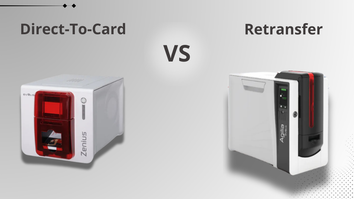When it comes to printing ID cards, choosing the right printer technology is crucial. Two of the most popular printing methods are Direct to Card (DTC) and Retransfer printing. Both methods offer unique advantages and are designed for different needs, depending on factors like card quality, durability, cost, and volume. In this blog, we’ll break down the differences between Direct to Card and Retransfer ID card printers, helping you make an informed decision for your organization's ID card printing needs.
What is Direct to Card (DTC) Printing?
Direct to Card (DTC) printing, also known as dye-sublimation printing, is a process where the printer prints directly onto the surface of a blank plastic card. The printer uses a print ribbon with colored panels (typically yellow, magenta, cyan, and black), which are heated by the printhead. This heat transfers the ink onto the card, producing a full-color image.
There are three Evolis DTC printers to consider: Primacy 2, Zenius, and Badgy. These printers are compact, user-friendly, and ideal for organizations looking for cost-effective and fast printing solutions.
Advantages of Direct to Card Printers
- Cost-Effective: DTC printers tend to be more affordable than Retransfer printers. They are a great choice for organizations that need basic card printing without breaking the budget.
- Fast Printing Speed: DTC printers generally have faster print times, making them ideal for organizations that need to produce a large volume of cards quickly.
- Compact Design: These printers are typically more compact and user-friendly, requiring less space and maintenance, which makes them ideal for small to medium-sized operations.
- Simplicity: DTC printers are straightforward to use, making them great for offices or organizations that don’t have specialized printing needs.
Limitations of Direct to Card Printing
- Edge-to-Edge Printing (Sort Of): While DTC printing provides near-edge-to-edge printing, it often leaves a small white border around the card because the printhead cannot reach the very edge of the card.
- Surface Imperfections: Since DTC printers print directly onto the card, any imperfections or surface irregularities (e.g., ridges, bumps, or chips) can affect the final print quality.
- Lower Durability: Cards printed with DTC technology may wear out more quickly because the ink is less resistant to scratches and fading over time.
- Limited to PVC Cards: DTC printers work best on standard PVC cards. Other card types, such as those with smart chips or proximity features, may be more challenging to print without affecting the quality.
What is Retransfer Printing?
Retransfer printing, also known as reverse transfer printing, works differently from DTC. Instead of printing directly onto the card, the printer first prints the image onto a clear film. This film is then fused onto the surface of the card. The process provides a higher-quality print and is more versatile with different types of cards, including those with embedded technology.
One Evolis retransfer printer to note is the Agilia, designed for organizations that require high-quality, durable card prints with true edge-to-edge results.
Advantages of Retransfer Printers
- True Edge-to-Edge Printing: Retransfer printers provide true edge-to-edge printing, meaning there are no white borders left around the card. This results in a more professional, polished appearance.
- Higher Print Quality: The use of a transfer film allows for more vibrant, detailed images. Retransfer printing provides better color depth and sharpness, making it ideal for high-definition or photo-quality cards.
- Durability: Cards printed with retransfer technology are more durable. The extra film layer acts as a protective barrier against scratches, fading, and wear and tear.
- Works with Complex Cards: Retransfer printers are excellent for printing on uneven surfaces like smart cards, proximity cards, and cards with embedded chips or ridges. The film conforms to the shape of the card, producing a clean, high-quality image.
- Longer Lifespan: Retransfer cards are better suited for long-term use due to their durability and resistance to environmental factors like UV light, moisture, and physical wear.
Limitations of Retransfer Printing
- Higher Cost: Retransfer printers are generally more expensive than DTC printers, both in terms of upfront cost and consumables. The added film layer increases the cost per card.
- Slower Print Speed: Retransfer printers are slower than DTC printers, as the process involves an additional step of applying the image to the transfer film before it’s fused to the card. This makes them less ideal for high-volume printing in a time-sensitive environment.
- Larger Footprint: Retransfer printers tend to be bulkier than DTC printers, which may not be ideal for organizations with limited space.
Which is Right for You?
Choosing between a Direct to Card and a Retransfer printer depends on your specific needs:
- If cost and speed are your primary concerns, and you don’t need perfect edge-to-edge printing, then a Direct to Card printer is the right choice.
- If you require high-quality, durable cards and often work with smart or proximity cards, investing in a Retransfer printer will be worth the additional cost.
Both technologies have their place in ID card printing. The key is to assess your organization’s needs, including budget, card volume, and the level of print quality required. Contact us today if you still have more questions about these two types of ID card printers.

